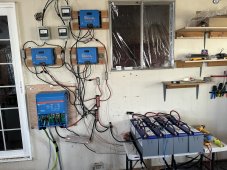Hedges
I See Electromagnetic Fields!
- Joined
- Mar 28, 2020
- Messages
- 20,681
Grounding generally has no impact on functionality. PV, SCC, battery, inverter will all work fine regardless (unless you ground both positive and negative.)
Grounding is primarily to ensure no exposed metal has a voltage different from the earth or any metal object you might touch, like a water pipe.
And, so that if a hot wire shorts to ground, it trips a breaker and shuts off the power (won't shut off PV, but might trip GFCI.) In the case of PV, it just holds the voltage at zero forever, so ground wire is sized same as current-carrying conductors rather than oversize.
Another guy, while standing on a ladder, got a shock from his metal roof. Grounding PV array fixed that. It was apparently AC being capacitively coupled to frame.
I haven't dug into your other thread, read it a bit.
"Low battery light in inverter" - check battery voltage, see if it indicates low SoC. Check voltage at inverter battery terminals, make sure it is about the same. Try that under heavy load.
Grounding is primarily to ensure no exposed metal has a voltage different from the earth or any metal object you might touch, like a water pipe.
And, so that if a hot wire shorts to ground, it trips a breaker and shuts off the power (won't shut off PV, but might trip GFCI.) In the case of PV, it just holds the voltage at zero forever, so ground wire is sized same as current-carrying conductors rather than oversize.
Another guy, while standing on a ladder, got a shock from his metal roof. Grounding PV array fixed that. It was apparently AC being capacitively coupled to frame.
I haven't dug into your other thread, read it a bit.
"Low battery light in inverter" - check battery voltage, see if it indicates low SoC. Check voltage at inverter battery terminals, make sure it is about the same. Try that under heavy load.



